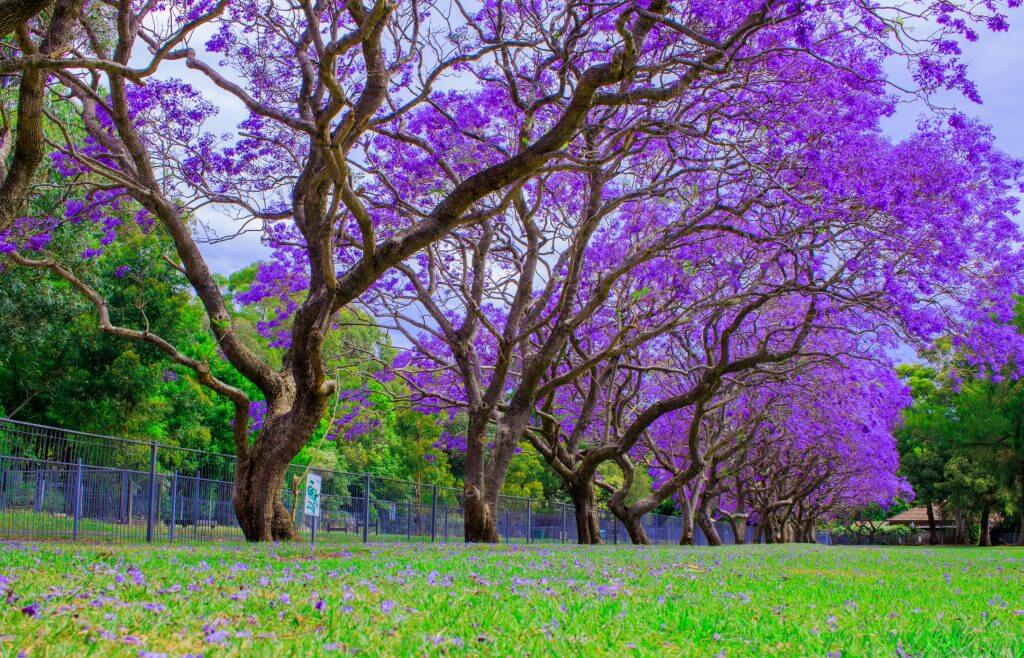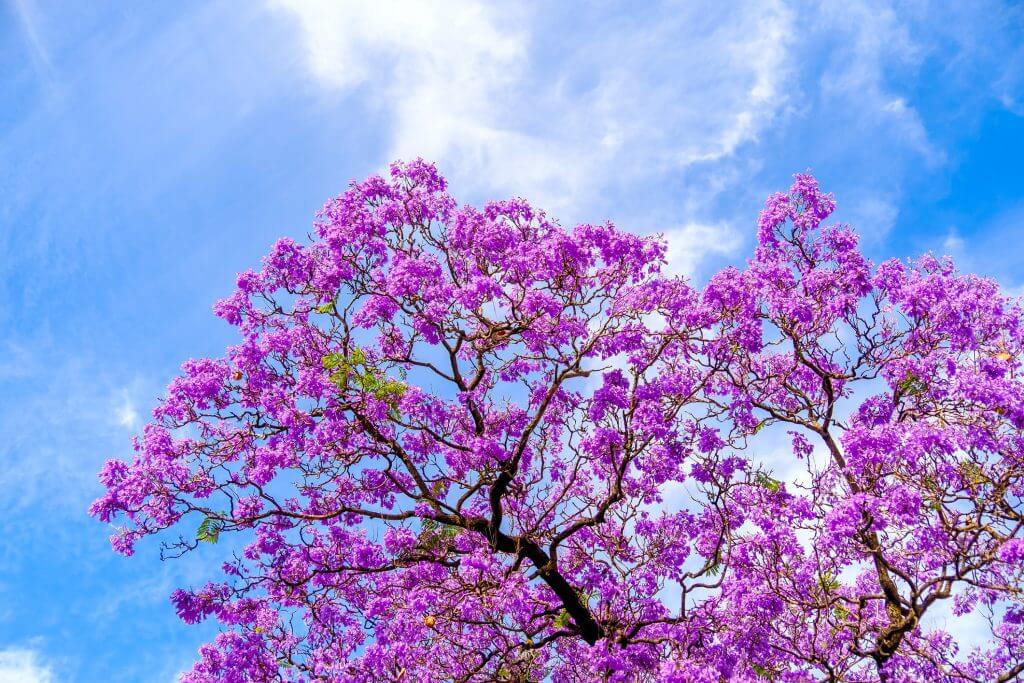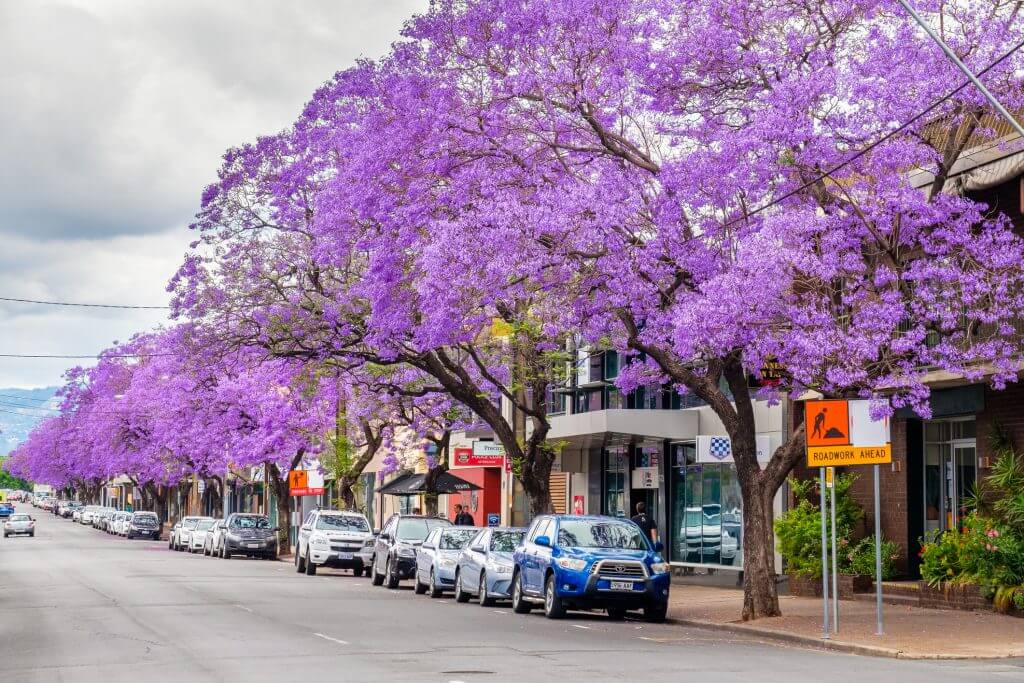You will not miss a blooming jacaranda tree that brightens up any landscape.
The jacaranda tree would make any garden seem like a fairy tale scene with the splash of pink, blue, indigo, or purple flowers.
Jacaranda trees also form a natural arch and have a broad canopy that is perfect for providing shade.

Basics of Jacaranda Tree
Jacaranda tree, or Jacaranda mimosifolia, is native to South America.
It has become very popular and planted in many other places and is known by other common names such as fern tree, black poui, or blue jacaranda.
This sub-tropical native tree can grow up to 66 feet (20 metres). The average mature height is about 25 to 50 feet (7.5 to 15 metres), and the width is about 15 to 30 feet (4.5 to 9 metres).
It has a thin and grey-brown bark that is finely scaly. Younger jacaranda trees have smoother trunks.
Jacaranda trees bloom in spring or early summer, with their bright display lasting for around two months. The jacaranda tree’s flowers can grow up to 2 inches (5 cm) long, and come in bunches or panicles of about 12 inches (30 cm).
After the blooms, the jacaranda trees grow seed pods, about 2 inches (5 cm) in diameter, which contains many flat and winged seeds.
Jacaranda trees will grow in most places with no risk of frost, but established mature jacaranda will tolerate brief sub-freezing temperatures of about 19 °F (-7 °C).


Planting Your Jacaranda Tree
Jacaranda trees can be grown from seeds, or you can buy a plant or young tree.
If planting from seeds, soak the jacaranda seeds in water for 24 hours.
Place the soaked seeds in a bed of soil in small pots or seedling containers. Cover with a thin layer of soil and lightly water to moisten the soil.
The jacaranda tree seeds should sprout in about two weeks.
Jacaranda tree seedlings need to be about eight months old before transplanting.
They need to be planted in sandy and well-draining, and moderately acidic soil.
They will thrive in places where there is no risk of frost, at least until the tree is established.
Plant the jacaranda tree or seedling in a place with full sun.
Water it deeply after planting. Wait and let it dry out between waterings.
Jacaranda trees can be grown indoors, but they will not produce blooms.
Choose a spot for your jacaranda tree, taking into consideration that its flowers will drop and need to be removed before they start to decompose.
The reason for that is that jacaranda flowers tend to decompose into slime. But that is not a reason to be put off and not plant this tree, as it is easy to rake the flowers off.
Another reason to be mindful where you plant the jacaranda tree is how it could affect other plants in the area. Jacaranda trees can be invasive and may be detrimental to the growth of native flora.
Beautiful as it is, the jacaranda tree is sometimes considered as an invasive species such as in some parts of Australia and South Africa.
In Australia, the jacaranda tree has been seen to prevent the growth of some native species.


How to Take Care of Your Jacaranda Tree
Jacaranda trees need to be pruned regularly to keep it in the best shape.
In early spring prune small branches and any plant sucker or offshoots—that unwanted growth towards the bottom of the tree-like branch or another tree.
Feed your jacaranda tree once a year with the necessary fertiliser, specifically with low nitrogen. Too much nitrogen will prevent the jacaranda tree from flowering.
Make sure to let the soil dry on top before each watering, but do not allow the jacaranda tree to go too long without water.


Problems with Jacaranda Trees
Jacaranda trees generally only have minor problems, if any.
Just like most garden flora, jacaranda trees can get scale and aphids. Most available pesticides can address these.
While jacaranda trees are drought-tolerant, they can still suffer when they stay dry for too long.
As mentioned above, too much fertiliser, especially with too much nitrogen, can prevent the jacaranda tree from flowering.
If the soil is not draining sufficiently, it can cause root rot. It will also make the jacaranda tree’s roots more susceptible to stem and root rot pathogens.
The most severe problem the jacaranda tree could have is the oleander scorch disease which is caused by the lethal bacteria Xylella fastidiosa. This infection can be caused by another pest, the glassy-winged sharpshooter which could infest the leaves. Unfortunately, there is no cure for the oleander scorch disease.
[elementor-template id=”4604″]
[elementor-template id=”6387″]
